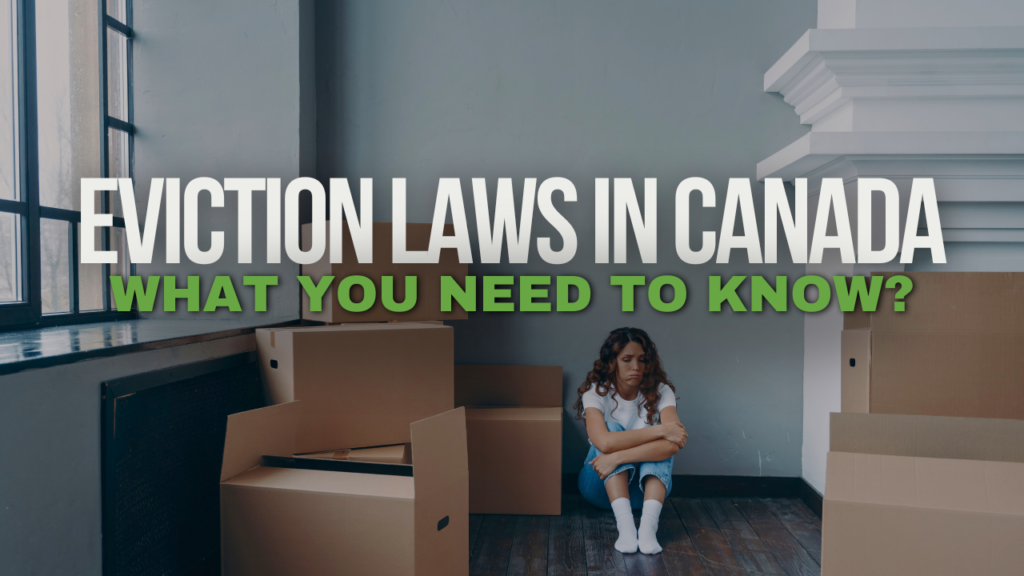Eviction Laws in Canada: What You Need to Know
Introduction
Eviction Laws in Canada are a sensitive and legally complex process in Canada, with strict regulations in place to protect both landlords and tenants. Whether you’re a property owner or a tenant, understanding eviction laws is crucial to avoid legal issues. In Ontario, the Residential Tenancies Act (RTA) governs the eviction process, and landlords must follow the proper procedures outlined by the Landlord and Tenant Board (LTB).

This guide focuses on eviction laws in Hamilton and Niagara, Ontario, ensuring you have the right information to handle rental disputes legally and efficiently.
1. Legal Grounds for Eviction in Canada
In Canada, landlords can only evict tenants under specific legal grounds. In Ontario, the following are recognized reasons for eviction:
Non-Payment of Rent
- If a tenant fails to pay rent on time, the landlord can issue an N4 Notice to End a Tenancy Early for Non-payment of Rent.
- The tenant has 14 days to pay before the landlord can file for eviction with the LTB.
Lease Violations
- Examples: Damage to the property, excessive noise, illegal activities.
- Landlords must serve an N5 Notice to End a Tenancy for Interfering with Others, Damage, or Overcrowding.
- The tenant has 7 days to rectify the issue before further legal action is taken.
Landlord’s Personal Use
- A landlord can evict a tenant if they or an immediate family member (parent, spouse, child) intend to move into the rental unit.
- Landlords must serve an N12 Notice to End a Tenancy for Landlord’s Personal Use with at least 60 days’ notice.
- Compensation: One month’s rent or a comparable unit must be offered to the tenant.
Property Sale or Major Renovations
- If the rental unit is being sold and the new buyer intends to occupy it, the landlord must issue an N12 Notice.
- If major renovations require the tenant to vacate, landlords must issue an N13 Notice to End a Tenancy for Renovations or Demolition.
- In some cases, the tenant has the right of first refusal to move back in after renovations.
End of Lease Agreements
- If a fixed-term lease expires, tenants automatically switch to a month-to-month tenancy, unless they provide notice to leave.
- A landlord cannot force a tenant to leave at the end of a lease unless there is a valid reason recognized by the LTB.
Resources:
2. The Eviction Process in Ontario
Step 1: Issuing the Correct Eviction Notice
- Landlords must issue the correct LTB-approved form (N4, N5, N12, N13, etc.).
- Notices must include specific details about the reason for eviction and the required notice period.
Step 2: Tenant’s Response Period
- Tenants have the right to dispute the eviction notice within the timeframe listed on the notice.
- If the issue is resolved (e.g., rent is paid, damage is repaired), the eviction cannot proceed.
Step 3: Filing an Application with the LTB
- If the tenant does not comply, landlords must file an application with the Landlord and Tenant Board.
- The LTB will schedule a hearing where both parties can present their case.
Step 4: Attending the Hearing
- The LTB may issue an eviction order if the landlord provides sufficient evidence.
- Tenants can appeal the decision under certain conditions.
Step 5: Enforcement by the Sheriff
- If the tenant refuses to leave, the landlord cannot remove them.
- Only the Court Enforcement Office (Sheriff) can legally remove a tenant after an eviction order.
Resources:
3. Tenant Protections and Landlord Responsibilities
- Proper notice periods: Each eviction type has a different notice period.
- Wrongful evictions: If a landlord evicts a tenant for personal use but does not move in, the tenant can file a claim for bad faith eviction, which can lead to fines and compensation.
- Compensation: Some evictions, like those for personal use or renovations, require landlords to pay tenants at least one month’s rent.
Resources:
4. Challenges Landlords Face & How to Handle Evictions Properly
Common Eviction Challenges
- Delays in the LTB process (backlogs can cause hearings to take months).
- Tenants refusing to vacate (enforcement must go through the sheriff).
- Retaliatory actions by tenants (damage to property, refusal to pay rent).
How to Avoid Eviction Issues
- Conduct thorough tenant screening before signing a lease.
- Maintain clear lease agreements with documented rules and expectations.
- Use a property management company to handle rent collection and legal issues.
Resources:
5. Final Tips & Legal Support for Landlords
- Seek legal advice if an eviction case becomes complicated.
- Consider alternatives to eviction (mediation, rent payment plans, etc.).
- Work with a property management company to navigate evictions legally and efficiently.
Conclusion
Evictions are a complex legal process that require landlords to follow strict procedures. The Residential Tenancies Act (RTA) and Landlord and Tenant Board (LTB) ensure that tenants’ rights are protected, and landlords must adhere to legal requirements to avoid fines or disputes.
If you’re a landlord in Hamilton or Niagara, understanding eviction laws can save you time, money, and legal trouble. Working with a professional property management company can also help you handle tenant issues properly and avoid costly eviction mistakes.
